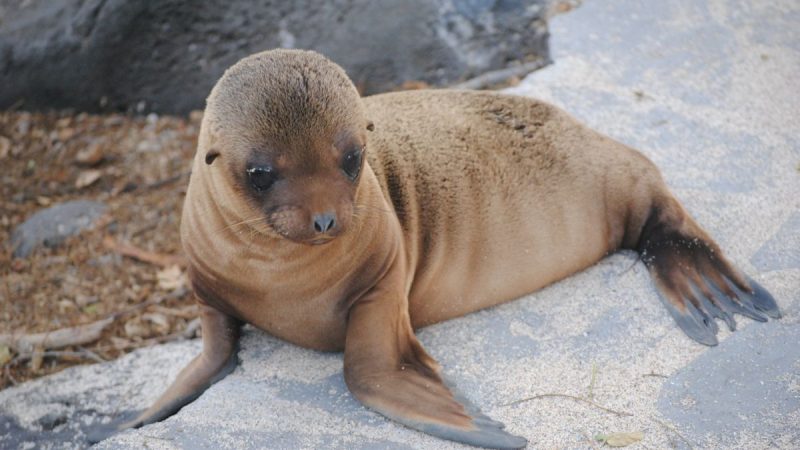The Galapagos Sea Lion is a charismatic and captivating creature that inhabits the stunning Galapagos Islands, a haven for wildlife enthusiasts. These playful, social marine mammals are often seen lounging on the beaches or frolicking in the waters, delighting visitors with their antics. While they are commonly spotted by tourists, there are many fascinating facts about the Sea Lion that might surprise you. In this article, we explore 10 intriguing facts about these remarkable creatures, offering a deeper understanding of their behavior, habitat, and unique features.
Native to the Galapagos Islands
The Galapagos Sea Lion, scientifically known as Zalophus wollebaeki, is native to the Galapagos Islands, an archipelago located in the Pacific Ocean. Unlike other sea lion species, the Sea Lion is found exclusively in this region. The Galapagos Islands provide a perfect environment for these sea lions, with its isolated beaches and abundant food sources. The Galapagos Sea Lion is one of the few species of sea lions that are not found on the mainland, making them an endemic species of the archipelago.
Highly Social Creatures
Galapagos Sea Lions are known for their social behavior, often found in large groups called colonies. These colonies can vary in size, with some containing hundreds of individuals. Sea lions are highly interactive and communicate with each other through a variety of vocalizations, body postures, and movements. Mothers and pups maintain strong bonds, and sea lions engage in playful behavior, such as chasing and splashing in the water. Their social nature also makes them more visible and accessible to human observers.
Excellent Swimmers and Divers
The Galapagos Sea Lion is an exceptional swimmer, thanks to its streamlined body and strong flippers. They can swim at impressive speeds, reaching up to 25 miles per hour in short bursts, which helps them catch fish and evade predators. Their swimming skills are complemented by their ability to dive to impressive depths. These sea lions are known to dive as deep as 600 feet in search of food, often hunting for fish, squid, and octopuses. Their agility in the water is a key factor in their survival in the competitive marine ecosystem of the Galapagos Islands.
Playful Personalities
One of the most endearing traits of the Galapagos Sea Lion is its playful nature. These animals are often seen engaging in various forms of play, from swimming in circles to playing with seaweed or even chasing their own tails. They have been known to approach boats and kayaks, curiously inspecting human visitors. Their playful demeanor and curiosity make them a favorite among wildlife watchers, who often witness these sea lions frolicking in the shallow waters near the shore.
Sexual Dimorphism: Males and Females Look Different
Sexual dimorphism, a difference in physical appearance between males and females, is evident in the Galapagos Sea Lion. Males are much larger than females, with adult males weighing up to 250 kg (550 lbs) and measuring up to 2.4 meters (8 feet) long. In contrast, females are significantly smaller, weighing around 50–70 kg (110–155 lbs) and measuring about 1.5 meters (5 feet) long. The males also sport a larger, more robust head with a mane-like feature around their neck. During mating season, males use their size and vocalizations to establish dominance and claim territories.
Pups Have a Unique “Crying” Call
Baby Galapagos Sea Lions, known as pups, have a distinctive vocalization that helps them communicate with their mothers. This “crying” call is loud and persistent, ensuring that the mother can locate her pup even in a crowded colony. Pups are born with a dark coat of fur, which they shed as they grow older. Initially, they are highly dependent on their mothers for milk, which they consume until they are old enough to begin hunting on their own. The bond between mother and pup is vital for the pup’s survival, as the mother provides not only nourishment but also protection.
They Have a Wide Range of Vocalizations
In addition to their “crying” calls, Galapagos Sea Lions are known for their wide range of vocalizations. They communicate with each other using barks, growls, and roars. Males often vocalize loudly to assert their dominance over a territory, while females use softer vocalizations to communicate with their pups. These vocalizations play a crucial role in maintaining social structures within the colony and are also important during the mating season, where males attempt to attract females by producing distinct sounds.
Endangered but Protected
The Galapagos Sea Lion is currently classified as “Endangered” by the International Union for Conservation of Nature (IUCN). The population of these sea lions has fluctuated over the years, with threats such as habitat destruction, climate change, and human interference impacting their numbers. However, conservation efforts in the Galapagos Islands have been successful in reducing these threats. The Galapagos National Park and the Charles Darwin Foundation work together to protect these sea lions and their habitats, ensuring their long-term survival.
They Can Live Up to 20 Years
Galapagos Sea Lions have a relatively long lifespan for marine mammals, with some individuals living up to 20 years in the wild. However, their life expectancy can vary depending on factors such as food availability and the presence of predators. While they are not typically preyed upon by other animals, young sea lions can sometimes fall victim to sharks, orcas, and other predators. Their ability to adapt to different environments and their strong social bonds help them thrive in the challenging conditions of the Galapagos Islands.
Galapagos Sea Lions Are Key to the Ecosystem
As top predators in the Galapagos marine ecosystem, Galapagos Sea Lions play a crucial role in maintaining the balance of the local food web. By hunting fish, squid, and other marine animals, they help control the populations of these species, preventing overpopulation and promoting biodiversity. Additionally, their presence in the ecosystem provides food for predators such as sharks and orcas, ensuring that the entire ecosystem remains healthy and balanced.
Conclusion
The Galapagos Sea Lion is an incredible animal that embodies the spirit of the Galapagos Islands. From their playful behavior to their important role in the marine ecosystem, these sea lions are truly fascinating creatures. Their social bonds, unique physical traits, and impressive swimming abilities make them a symbol of the islands’ natural wonders. While they face conservation challenges, efforts are being made to protect their populations and ensure their future. The Galapagos Sea Lion serves as a reminder of the importance of preserving the delicate balance of nature and the creatures that depend on it.
FAQs
Q1.What do these sea lions eat?
These marine mammals primarily feed on fish, squid, and octopuses, which they hunt by diving into the surrounding waters.
Q2.How long do they live in the wild?
These creatures can live up to 20 years in the wild, though their life expectancy may vary due to environmental conditions and predators.
Q3.Are these animals at risk of extinction?
Yes, they are considered endangered, and conservation efforts are underway to protect their populations and preserve their habitat.
Q4.Is it safe to interact with them during a visit?
While these animals are curious and playful, it’s important to maintain a respectful distance and avoid disturbing their natural behavior.
Q5.What are the physical differences between males and females?
Males are significantly larger than females and feature a more robust head with a mane-like appearance, while females are smaller and more streamlined.
Also read: What Animals Live in the Arctic? 10 Majestic and Fearless Creatures That Thrive in the Cold









